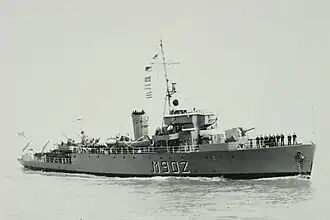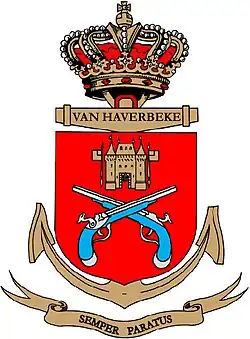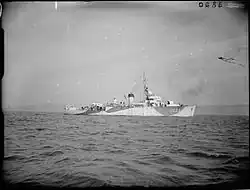HMS Ready (J223)
 A. F. Dufour (M902)
| |
| History | |
|---|---|
| Name | Ready |
| Namesake | Ready |
| Ordered | 15 November 1940 |
| Builder | Harland & Wolff, Belfast |
| Laid down | 14 April 1942 |
| Launched | 11 January 1943 |
| Commissioned | 21 May 1943 |
| Decommissioned | 1948 |
| Reclassified | M223, 1949 |
| Identification | Pennant number: J223 |
| Fate | Sold to the Belgium, 1951 |
| Name | Van Haverbeke |
| Namesake | J.F. Van Haverbeke[1] |
| Acquired | 1951 |
| Commissioned | 4 July 1951 |
| Decommissioned | June 1960 |
| Stricken | June 1960 |
| Identification |
|
| Motto |
|
| Fate | Scrapped, 1961 |
| Badge |  |
| General characteristics | |
| Class & type | Algerine-class minesweeper |
| Displacement |
|
| Length | 225 ft (69 m) o/a |
| Beam | 35 ft 6 in (10.82 m) |
| Draught | 11 ft 6 in (3.51 m) |
| Installed power |
|
| Propulsion |
|
| Speed | 16.5 knots (30.6 km/h; 19.0 mph) |
| Range | 5,000 nmi (9,300 km; 5,800 mi) at 10 knots (19 km/h; 12 mph) |
| Complement | 85 |
| Armament | |
HMS Ready (J226) was a steam turbine-powered Algerine-class minesweeper during the Second World War. She survived the war and was sold to Belgium in 1951 as Van Haverbeke (M902).
Design and description

The turbine-powered ships displaced 850 long tons (860 t) at standard load and 1,125 long tons (1,143 t) at deep load. The ships measured 225 feet (68.6 m) long overall with a beam of 35 feet 6 inches (10.8 m). The turbine group had a draught of 11 feet (3.4 m). The ships' complement consisted of 85 officers and ratings.[2]
The ships had two Parsons geared steam turbines, each driving one shaft, using steam provided by two Admiralty three-drum boilers. The engines produced a total of 2,000 indicated horsepower (1,500 kW) and gave a maximum speed of 16.5 knots (30.6 km/h; 19.0 mph). They carried a maximum of 660 long tons (671 t) of fuel oil that gave them a range of 5,000 nautical miles (9,300 km; 5,800 mi) at 10 knots (19 km/h; 12 mph).[2]
The Algerine class was armed with a QF 4 in (102 mm) Mk V anti-aircraft gun[3] and four twin-gun mounts for Oerlikon 20 mm cannon. The latter guns were in short supply when the first ships were being completed and they often got a proportion of single mounts. By 1944, single-barrel Bofors 40 mm mounts began replacing the twin 20 mm mounts on a one for one basis. All of the ships were fitted for four throwers and two rails for depth charges.[2]
Construction and career
Service in the Royal Navy
The ship was ordered on 15 November 1940 at the Harland & Wolff at Belfast, Ireland. She was laid down on 14 April 1942 and launched on 11 January 1943. She was commissioned on 21 May 1943.[4]
On 29 December 1944 she captured the miniature submarine Biber 90 which was found with its sole crew-member dead from carbon monoxide poisoning.[5] It was towed to Dover although sunk in the harbour before being recovered.[5]
Ready was decommissioned in 1948.
She was then sold to Belgium in 1951.
Service in the Belgian Navy
Ready was renamed Van Haverbeke and was commissioned on 4 July 1951.[1]
The ship was decommissioned in June 1960 and sold for to Mr. Bakker P.V.B.A, Bruges for scrap on 7 March 1961.[1]
References
- ^ a b c "Van Haverbeke". www.marinebelge.be (in French). Retrieved 12 April 2025.
- ^ a b c Lenton, p. 261
- ^ Chesneau, p. 65
- ^ "HMS Ready (J 223) of the Royal Navy - British Minesweeper of the Algerine class - Allied Warships of WWII - uboat.net". uboat.net. Retrieved 6 September 2021.
- ^ a b Bullen, John (1989). "The German Biber submarine". Imperial War Museum Review. 4: 79–86.
Bibliography
- Chesneau, Roger, ed. (1980). Conway's All the World's Fighting Ships 1922–1946. Greenwich, UK: Conway Maritime Press. ISBN 0-85177-146-7.
- Colledge, J. J.; Warlow, Ben (2006) [1969]. Ships of the Royal Navy: The Complete Record of all Fighting Ships of the Royal Navy (Rev. ed.). London: Chatham Publishing. ISBN 978-1-86176-281-8.
- Elliott, Peter (1977). Allied Escort Ships of World War II: A complete survey. London: Macdonald and Jane's. ISBN 0-356-08401-9.
- Lenton, H. T. (1998). British & Empire Warships of the Second World War. Annapolis, Maryland: Naval Institute Press. ISBN 1-55750-048-7.